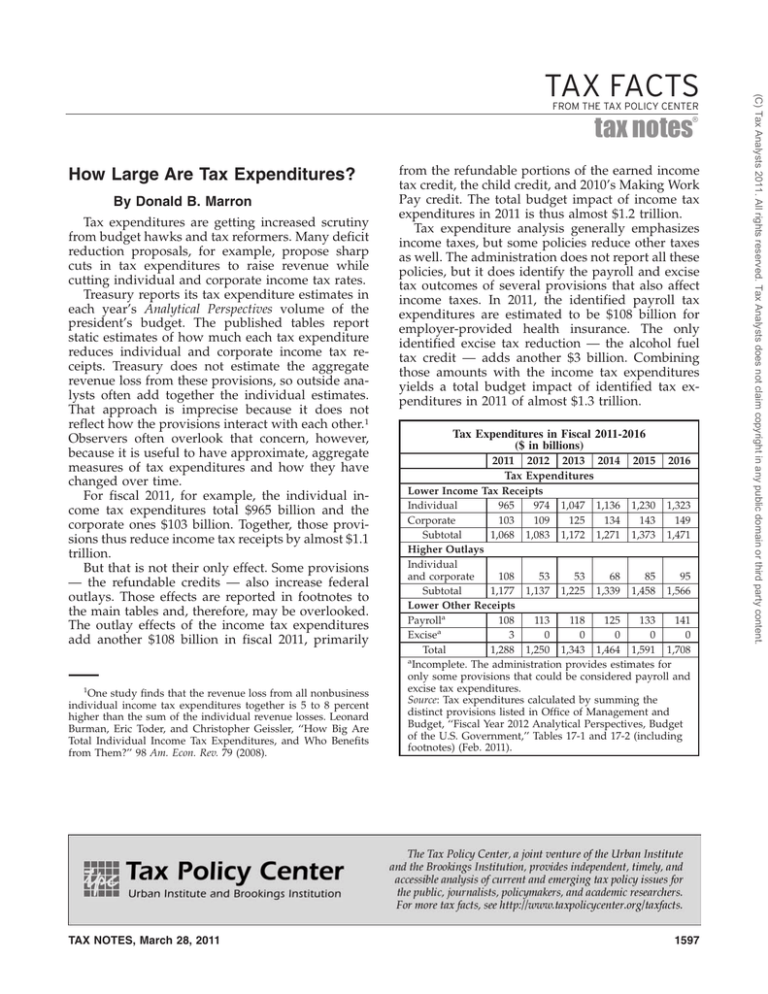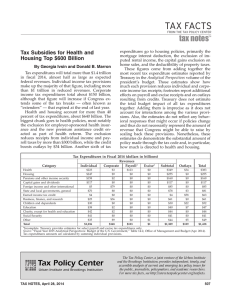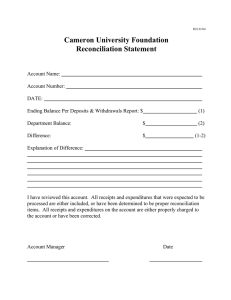
FROM THE TAX POLICY CENTER
®
tax notes
How Large Are Tax Expenditures?
By Donald B. Marron
Tax expenditures are getting increased scrutiny
from budget hawks and tax reformers. Many deficit
reduction proposals, for example, propose sharp
cuts in tax expenditures to raise revenue while
cutting individual and corporate income tax rates.
Treasury reports its tax expenditure estimates in
each year’s Analytical Perspectives volume of the
president’s budget. The published tables report
static estimates of how much each tax expenditure
reduces individual and corporate income tax receipts. Treasury does not estimate the aggregate
revenue loss from these provisions, so outside analysts often add together the individual estimates.
That approach is imprecise because it does not
reflect how the provisions interact with each other.1
Observers often overlook that concern, however,
because it is useful to have approximate, aggregate
measures of tax expenditures and how they have
changed over time.
For fiscal 2011, for example, the individual income tax expenditures total $965 billion and the
corporate ones $103 billion. Together, those provisions thus reduce income tax receipts by almost $1.1
trillion.
But that is not their only effect. Some provisions
— the refundable credits — also increase federal
outlays. Those effects are reported in footnotes to
the main tables and, therefore, may be overlooked.
The outlay effects of the income tax expenditures
add another $108 billion in fiscal 2011, primarily
1
One study finds that the revenue loss from all nonbusiness
individual income tax expenditures together is 5 to 8 percent
higher than the sum of the individual revenue losses. Leonard
Burman, Eric Toder, and Christopher Geissler, ‘‘How Big Are
Total Individual Income Tax Expenditures, and Who Benefits
from Them?’’ 98 Am. Econ. Rev. 79 (2008).
TAX NOTES, March 28, 2011
from the refundable portions of the earned income
tax credit, the child credit, and 2010’s Making Work
Pay credit. The total budget impact of income tax
expenditures in 2011 is thus almost $1.2 trillion.
Tax expenditure analysis generally emphasizes
income taxes, but some policies reduce other taxes
as well. The administration does not report all these
policies, but it does identify the payroll and excise
tax outcomes of several provisions that also affect
income taxes. In 2011, the identified payroll tax
expenditures are estimated to be $108 billion for
employer-provided health insurance. The only
identified excise tax reduction — the alcohol fuel
tax credit — adds another $3 billion. Combining
those amounts with the income tax expenditures
yields a total budget impact of identified tax expenditures in 2011 of almost $1.3 trillion.
Tax Expenditures in Fiscal 2011-2016
($ in billions)
2011 2012 2013 2014
Tax Expenditures
2015
2016
Lower Income Tax Receipts
Individual
965
974 1,047 1,136 1,230 1,323
Corporate
103
109
125
134
143
149
Subtotal
1,068 1,083 1,172 1,271 1,373 1,471
Higher Outlays
Individual
and corporate
108
53
53
68
85
95
Subtotal
1,177 1,137 1,225 1,339 1,458 1,566
Lower Other Receipts
108
113
118
125
133
141
Payrolla
3
0
0
0
0
0
Excisea
Total
1,288 1,250 1,343 1,464 1,591 1,708
a
Incomplete. The administration provides estimates for
only some provisions that could be considered payroll and
excise tax expenditures.
Source: Tax expenditures calculated by summing the
distinct provisions listed in Office of Management and
Budget, ‘‘Fiscal Year 2012 Analytical Perspectives, Budget
of the U.S. Government,’’ Tables 17-1 and 17-2 (including
footnotes) (Feb. 2011).
1597
(C) Tax Analysts 2011. All rights reserved. Tax Analysts does not claim copyright in any public domain or third party content.
TAX FACTS





